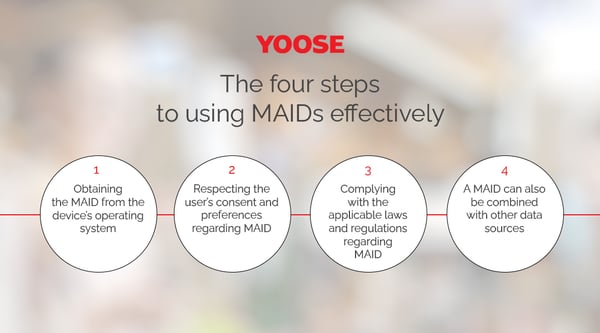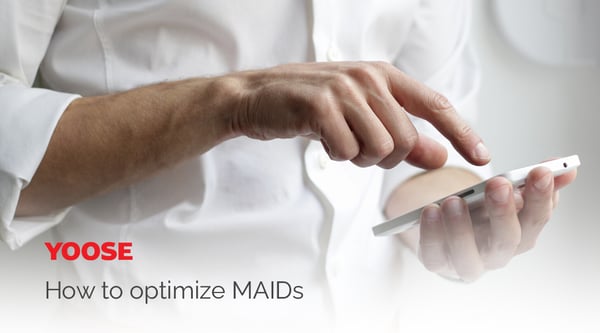Unveil the secrets of Mobile Advertising ID: Enhance your business with Location-based Marketing
If you use a smartphone or a tablet, there are chances that you have a mobile advertising ID (MAID) assigned to your device. A MAID is a unique identifier that allows advertisers and app developers to track your online behavior and preferences across different apps and websites. In this blog post, we will explain what a MAID is, how it works, and what you can do to control your privacy.
What does MAID mean in marketing?
In marketing, MAID stands for "Mobile Advertising ID." A MAID is a unique identifier assigned to a mobile device, such as a smartphone or tablet. This ID plays a crucial role in mobile advertising and marketing strategies. Advertisers and marketers use MAIDs to track user behavior, preferences, and engagement within mobile applications. By analyzing data associated with these IDs, marketers can gain valuable insights into their target audience, measure the effectiveness of advertising campaigns, and deliver personalized content or advertisements to users. MAIDs enable advertisers to reach their audience more effectively, optimize ad spend, and enhance the overall user experience in the mobile app ecosystem.
The four steps to using MAIDs effectively
An effective application of the MAID framework requires advertisers to adhere to three essential steps:
- Obtaining the MAID from the device’s operating system. Depending on the platform, different methods can be used to access the MAID. For instance, on Android devices, the Google Play Services API can be used to get the Google Advertising ID (GAID). On iOS devices, the AdSupport framework can be used to get the Identifier for Advertisers (IDFA).
- Respecting the user’s consent and preferences regarding MAID. Some users may opt out of interest-based advertising or reset their MAID periodically. The user’s settings should be checked before using their MAID and their choices should be honored. For instance, on Android devices, the Limit Ad Tracking Enabled method can be used to check if the user has opted out of interest-based advertising. On iOS devices, the Advertising Tracking Enabled property can be used to check if the user has limited ad tracking.

- Complying with the applicable laws and regulations regarding MAID. Different countries and regions may have different rules and requirements for using MAID and protecting user privacy. The legal counsel should be consulted and the best practices for using MAID in the target markets should be followed. For instance, in the European Union, the General Data Protection Regulation (GDPR) requires obtaining the user’s consent before using their MAID for advertising purposes.
- A MAID can also be combined with other data sources, such as users’ location, IP address, device type, browser type, and app usage, to create a more detailed profile of online behavior and preferences. This can help advertisers and app developers to provide more relevant and engaging experiences for users, but it can also raise some privacy concerns.
How can MAIDs be used to improve customer experience
Mobile advertising ID has several advantages for users, advertisers, and the mobile industry. These include:

- User privacy and control. Users have the option to reset their mobile advertising ID whenever they want, or to opt out of interest-based advertising completely. This enables users to manage how their data is collected and shared by advertisers.
- User experience and satisfaction. Users can benefit from ads that are more relevant and customized to their interests, needs, and preferences, rather than generic or irrelevant ads. This can improve user engagement and retention, as well as reduce ad fatigue and annoyance.
- Advertiser revenue and return on investment (ROI). Advertisers can target their ideal customers more effectively and efficiently, as well as optimize their ad frequency and budget. This can result in higher conversion rates, sales, and profits for advertisers.
- Innovation and competition in the mobile ecosystem. Mobile advertising ID allows advertisers to access a diverse and dynamic market of mobile users, as well as leverage various platforms and tools for data analysis and optimization. This can foster innovation and creativity in the mobile advertising industry, as well as promote fair and healthy competition among different players.
Challenges

Privacy
Users may not be aware of how their data is collected, used, and shared by advertisers and third-party platforms. They may not have control over their MAID settings or opt-out options. Moreover, MAID can expose users to security risks, such as identity theft, fraud, or malware. Therefore, users need more education and awareness about MAID and its implications for their privacy.
Transparency
Advertisers may not have access to accurate and reliable data about user behavior and preferences, due to factors such as data fragmentation, data quality, and data fraud. For example, users may have multiple devices or MAIDs, which may result in inconsistent or incomplete data. Additionally, some users may deliberately manipulate or falsify their data, such as by using ad blockers, VPNs, or fake MAIDs. Therefore, advertisers need more standardization and verification of MAID data and its sources.
Regulation
MAID is subject to different laws and regulations in different countries and regions, which may affect how advertisers can collect, use, and share user data. For instance, some jurisdictions may require user consent or opt-in for MAID tracking, while others may prohibit or limit it. Furthermore, some jurisdictions may impose fines or penalties for non-compliance or violations of MAID regulations. Therefore, advertisers need more compliance and adaptation to the legal and ethical frameworks of MAID.
How to optimize MAIDs
Advertisers should adhere to some best practices that respect user privacy and comply with relevant regulations when using MAID.

These include:
- Using MAID only for legitimate purposes that benefit the user, such as providing relevant and useful ads, enhancing app functionality, or improving user satisfaction.
- Obtaining user consent before collecting, using, or sharing MAID. Providing clear and transparent information about how MAID is used and with whom it is shared. Allowing users to opt out of MAID collection or use at any time.
- Protecting MAID from unauthorized access or misuse. Implementing appropriate security measures to prevent data breaches or leaks. Deleting or anonymizing MAID when it is no longer needed or requested by the user.
- Respecting user preferences and choices regarding MAID. Honoring user requests to limit ad tracking, reset MAID, or delete personal data. Following the guidelines and policies of the operating systems and platforms that provide MAID.
- Monitoring and updating MAID practices regularly. Staying informed of the latest trends and developments in mobile advertising and privacy. Adapting to changing user expectations and regulatory requirements.
Conclusion
Mobile advertising ID (MAID) is a unique identifier that enables advertisers and app developers to track and target users across different apps and websites on mobile devices. MAID has various benefits for users, advertisers, and the mobile industry, but also poses some challenges that require more education, awareness, standardization, verification, and compliance from all stakeholders. MAID is a powerful and evolving tool for mobile advertising that requires careful and responsible use. If you want to learn more about MAID and how to optimize your mobile advertising strategy, contact YOOSE today for consultation.


